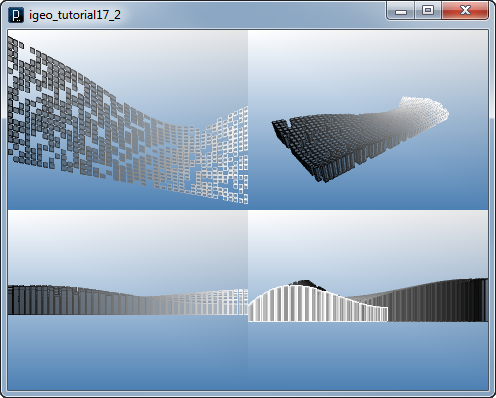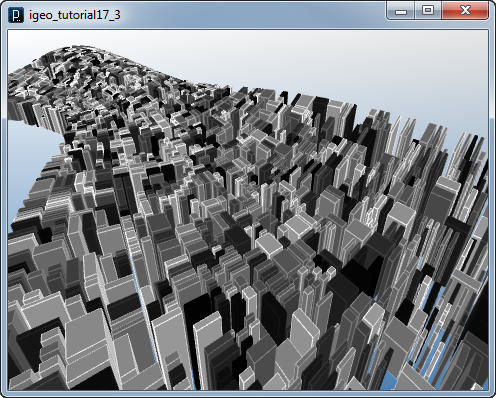

 Tutorials Tutorials | (back to the list of tutorials) |
 Panelization Example2
Panelization Example2First, the code below shows rectangular panelization with gaps.
![]()
![]()
![]()
![]()
import processing.opengl.*;
import igeo.*;
size(480,360,IG.GL);
IG.open("surface3.3dm");
ISurface[] surfs = IG.surfaces();
ISurface surf = surfs[0];
int unum = 10;
int vnum = 20;
double uinc = 1./unum;
double vinc = 1./vnum;
// gap ratio between rectangular panel
double gap = 0.25;
for(int i=0; i < unum; i++){
for(int j=0; j < vnum; j++){
IVec pt1 = surf.pt(i*uinc, j*vinc);
IVec pt2 = surf.pt((i+1-gap)*uinc, j*vinc);
IVec pt3 = surf.pt((i+1-gap)*uinc, (j+1-gap)*vinc);
IVec pt4 = surf.pt(i*uinc, (j+1-gap)*vinc);
new ISurface(pt1,pt2,pt3,pt4);
}
}
surf.del();

Next, the code below shows the use of IBox providing 8 points as corners of the box.
![]()
![]()
![]()
![]()
import processing.opengl.*;
import igeo.*;
size(480,360,IG.GL);
IG.open("surface3.3dm");
ISurface[] surfs = IG.surfaces();
ISurface surf = surfs[0];
int unum = 20;
int vnum = 40;
double uinc = 1./unum;
double vinc = 1./vnum;
double gap = 0.25;
for(int i=0; i < unum; i++){
for(int j=0; j < vnum; j++){
IVec pt1 = surf.pt(i*uinc, j*vinc);
IVec pt2 = surf.pt((i+1-gap)*uinc, j*vinc);
IVec pt3 = surf.pt((i+1-gap)*uinc, (j+1-gap)*vinc);
IVec pt4 = surf.pt(i*uinc, (j+1-gap)*vinc);
// bottom points
IVec bpt1 = pt1.dup();
IVec bpt2 = pt2.dup();
IVec bpt3 = pt3.dup();
IVec bpt4 = pt4.dup();
// move bottom points to xy-plane
bpt1.z=0;
bpt2.z=0;
bpt3.z=0;
bpt4.z=0;
// create a box randomly
if(IRandom.percent(80)){
new IBox(pt1,pt2,pt3,pt4,bpt1,bpt2,bpt3,bpt4).clr(1-j*vinc);
}
}
}
surf.del();


Finally, extra for loops for the subdivision inside existing for loops with random number.
![]()
![]()
![]()
![]()
import processing.opengl.*;
import igeo.*;
size(480,360,IG.GL);
IG.open("surface3.3dm");
ISurface[] surfs = IG.surfaces();
ISurface surf = surfs[0];
int unum = 20;
int vnum = 40;
double uinc = 1./unum;
double vinc = 1./vnum;
double gap = 0.15;
for(int i=0; i < unum; i++){
for(int j=0; j < vnum; j++){
// random subdivision
int udiv=IRandom.getInt(1,2);
int vdiv=IRandom.getInt(1,4);
double uinc2 = 1./udiv;
double vinc2 = 1./vdiv;
for(int k=0; k < udiv; k++){
for(int l=0; l < vdiv; l++){
IVec pt1 = surf.pt((i + k*uinc2)*uinc,
(j + l*vinc2)*vinc);
IVec pt2 = surf.pt((i+(k+1)*uinc2-gap )*uinc,
(j + l*vinc2)*vinc);
IVec pt3 = surf.pt((i+(k+1)*uinc2-gap)*uinc,
(j+(l+1)*vinc2-gap)*vinc);
IVec pt4 = surf.pt((i+k*uinc2)*uinc,
(j+(l+1)*vinc2-gap)*vinc);
// bottom points
IVec bpt1 = pt1.dup();
IVec bpt2 = pt2.dup();
IVec bpt3 = pt3.dup();
IVec bpt4 = pt4.dup();
// move bottom points to xy-plane
bpt1.z=0;
bpt2.z=0;
bpt3.z=0;
bpt4.z=0;
// lower the top randomly
if(IRandom.percent(20)){
pt1.z -= 3;
pt2.z -= 3;
pt3.z -= 3;
pt4.z -= 3;
}
// create a box randomly
if(IRandom.percent(80)){
new IBox(pt1,pt2,pt3,pt4,bpt1,bpt2,bpt3,bpt4).clr(IRandom.gray());
}
}
}
}
}
surf.del();


 HOME
HOME
 FOR PROCESSING
FOR PROCESSING
 DOWNLOAD
DOWNLOAD
 DOCUMENTS
DOCUMENTS
 TUTORIALS
TUTORIALS
 GALLERY
GALLERY
 SOURCE CODE(GitHub)
SOURCE CODE(GitHub)
 ABOUT
ABOUT
